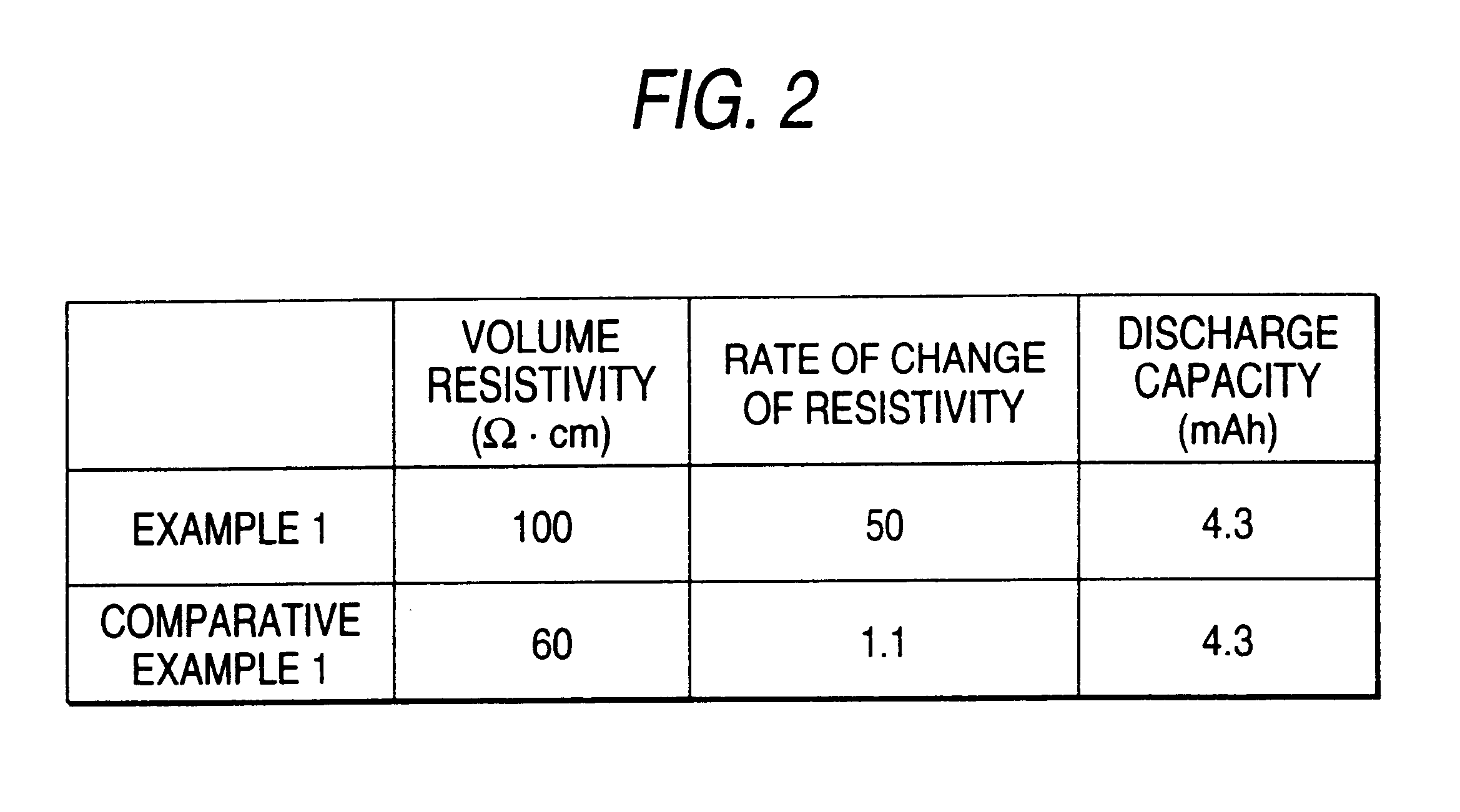Electrode, method of producing electrode, and cell comprising the electrode
a technology of electrodes and electrodes, applied in the field of electrochemical equipment, can solve the problems of battery inability to suppress an increase in short-circuit current, further increase of short-circuit current, and exothermic reaction
- Summary
- Abstract
- Description
- Claims
- Application Information
AI Technical Summary
Benefits of technology
Problems solved by technology
Method used
Image
Examples
example 2
Example 2 is characterized in that the electrode (positive electrode 1) was prepared in the same manner as in Example 1, except that the positive electrode active material paste was applied on aluminum foil, dried at 80.degree. C., and pressed at 135.degree. C. under a pressure of 0.5 ton / cm.sup.2 for 30 minutes. The negative electrode was prepared in the same manner as in Example 1. The characteristics of the resulting electrode and the battery having the electrode are shown in FIG. 9.
Because in Example 2 the dried paste is pressed at around the melting point of the resin contained in the electron conductive material 9, the adhesion between the current collector 4 and the active material layer 6 is improved thereby to reduce the contact resistance between the current collector 4 and the active material layer 6 as shown in the Figure. Further, the particles of the electron conductive material 9 deform and spread among the particles of the active material 8, while improving connectio...
example 3
Preparation of Positive Electrode:
An electron conductive material having a volume resistivity of 0.2 .cndot..multidot.cm at room temperature and of 500 .cndot..multidot.cm at a working temperature of 135.degree. C. (e.g., pellets comprising carbon black and polyethylene in a prescribed ratio) was pulverized by a jet mill method to prepare fine particles of the electron conductive material having an average particle size of 9.0 .mu.m.
Four-point-five parts by weight of the fine particles, 1.5 parts by weight of artificial graphite KS-6 (produced by LONZA Ltd.) as a conducting agent, 91 parts by weight of an active material (e.g., LiCoO.sub.2), and 3 parts by weight of a binder (e.g., PVDF) were dispersed in NMP, a dispersing medium, to prepare a positive electrode active material paste.
The paste was applied to a 20 .mu.m thick metal film (aluminum foil) serving as a positive electrode current collector 4 by a doctor blade coating method, dried at 80.degree. C., and pressed at a prescr...
example 4
Example 4 is characterized in that the positive electrode was prepared in the same manner as in Example 1, except that the electron conductive material was ground by a combined method and then further pulverized by a jet mill method. The negative electrode of Example 4 was prepared in the same manner as in Example 1.
FIG. 11 is a table showing average particle size of the electron conductive material used in the electrode (positive electrode 1) of Example 4. It is seen that the average particle size of Example 4 is smaller than in Example 1. Since the electron conductive material is reduced in size by a combined pulverizing method and then further pulverized by a jet mill method, the resulting particles of the electron conductive material have a reduced particle size with reduced variation of particle size, and the time required for pulverization can be shortened. Accordingly, an electrode prepared by using the resulting electron conductive material is highly flexible and easy to fab...
PUM
| Property | Measurement | Unit |
|---|---|---|
| melting point | aaaaa | aaaaa |
| particle size | aaaaa | aaaaa |
| temperature | aaaaa | aaaaa |
Abstract
Description
Claims
Application Information
 Login to View More
Login to View More - R&D
- Intellectual Property
- Life Sciences
- Materials
- Tech Scout
- Unparalleled Data Quality
- Higher Quality Content
- 60% Fewer Hallucinations
Browse by: Latest US Patents, China's latest patents, Technical Efficacy Thesaurus, Application Domain, Technology Topic, Popular Technical Reports.
© 2025 PatSnap. All rights reserved.Legal|Privacy policy|Modern Slavery Act Transparency Statement|Sitemap|About US| Contact US: help@patsnap.com



